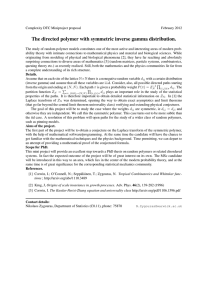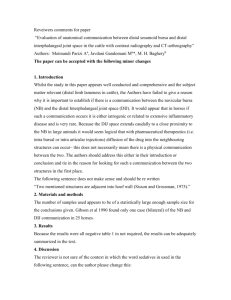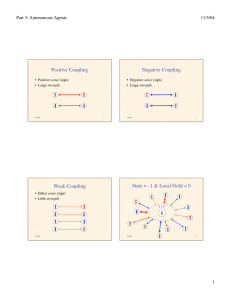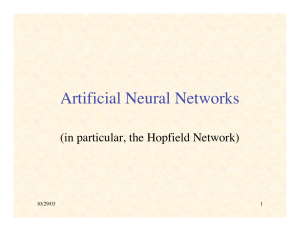Shortest Paths
advertisement
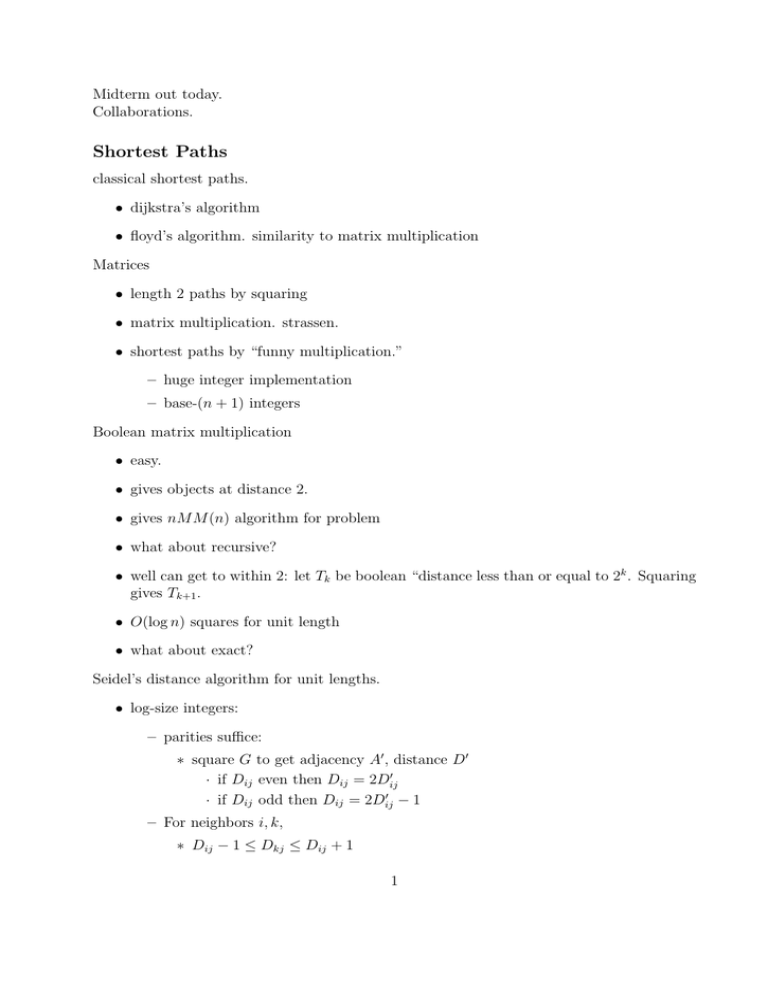
Midterm out today. Collaborations. Shortest Paths classical shortest paths. • dijkstra’s algorithm • floyd’s algorithm. similarity to matrix multiplication Matrices • length 2 paths by squaring • matrix multiplication. strassen. • shortest paths by “funny multiplication.” – huge integer implementation – base-(n + 1) integers Boolean matrix multiplication • easy. • gives objects at distance 2. • gives nM M (n) algorithm for problem • what about recursive? • well can get to within 2: let Tk be boolean “distance less than or equal to 2k . Squaring gives Tk+1 . • O(log n) squares for unit length • what about exact? Seidel’s distance algorithm for unit lengths. • log-size integers: – parities suffice: ∗ square G to get adjacency A� , distance D� � · if Dij even then Dij = 2Dij � · if Dij odd then Dij = 2Dij −1 – For neighbors i, k, ∗ Dij − 1 ≤ Dkj ≤ Dij + 1 1 ∗ exists k, Dkj = Dij − 1 – Parities � � ∗ If Dij even, then Dkj ≥ Dij for every neighbor k � � ∗ If Dij odd, then Dkj ≤ Dij for every neighbor k, and strict for at least one – Add � � ∗ Dij even iff Sij = k Dkj ≥ Dij d(i) � � ∗ Dij odd iff k Dkj < Dij d(i) ∗ How determine? find S = AD� • Result: all distances in O(M (n) log n) time. This is deterministic distance algorithm. To find paths: Witness product • example: tripartite one-hop hop case Modify matrix alg: • easy case: unique witness – multiply column c by c. – read off witness identity • reduction to easy case: – Suppose r columns have witness – Suppose choose each with prob. p – Prob. exactly 1 witness: rp(1 − p)r−1 ≈ 1/e – Try all values of r – Wait, too many. • Approx – Suppose p = 2/r – Then prob. exactly 1 is ≈ 2/e2 – So anything in range 1/r . . . 1/2r will do. – So try p all powers of 2. – suppose 2k ≤ r ≤ 2k+1 – choose each column with probability 2−k . – prob. exactly one witness: r · 2−k (1 − 2−k )r−1 ≥ (1/2)(1/e2 ) – so try log n distinct powers of 2, each O(log n) times • So, can find shortest paths by doing one Matrix mul for each distance value 2 – n matrix muls generalize to more distances: – distances now known – for each node, dest, find neighbor with distance one less – boolean matrix R of “distance is k − 1” – boolean witness product of RA • Mod 3: – Recall some neighbor distance down by one – so compute distances mod 3. – suppose Dij = 1 mod 3 – then look for k neighbor of i such that Dkj = 0 mod 3 (s) – let Dij = 1 iff Dij = s mod 3 (s) – than AD(s) has ij = 1 iff a neighbor k of i has Dkj – so, witness matrix mul! Parallel Algorithms PRAM • P processors, each with a RAM, local registers • global memory of M locations • each processor can in one step do a RAM op or read/write to one global memory location • synchronous parallel steps • various conflict resolutions (CREW, EREW, CRCW) • not realistic, but explores “degree of parallelism” Randomization in parallel: • load balancing • symmetry breaking • isolating solutions Classes: • NC: poly processor, polylog steps 3 • RNC: with randomization. polylog runtime, monte carlo • ZNC: las vegas NC • immune to choice of conflict resolution Practical observations: • very little can be done in o(log n) with poly processors • lots can be done in Θ(log n) • often concerned about work which is processors times time • algorithm is “optimal” if work equals best sequential Basic operations • and, or • counting ones • parallel prefix Addition • Prefix sum over “kill”, “propogate”, “carry” operations • handles n-bit numbers in O(log n) time • multiplication as n2 additions (better methods exist) Sorting Quicksort in parallel: • n processors • each takes one item, compares to splitter • count number of predecessors less than splitter • determines location of item in split • total time O(log n) • combine: O(log n) per layer with n processors • problem: Ω(log2 n) time bound • problem: n log2 n work 4 Perfect Matching We focus on bipartite; book does general case. Last time, saw detection algorithm in RN C: • Tutte matrix • Sumbolic determinant nonzero iff PM • assign random values in 1, . . . , 2m • Matrix Mul, Determinant in N C How about finding one? • If unique, no problem • Since only one nozero term, ok to replace each entry by a 1. • Remove each edge, see if still PM in parallel • multiplies processors by m • but still N C Idea: • make unique minimum weight perfect matching • find it Isolating lemma: [MVV] • Family of distinct sets over x1 , . . . , xm • assign random weights in 1, . . . , 2m • Pr(unique min-weight set)≥ 1/2 • Odd: no dependence on number of sets! • (of course < 2m ) Proof: • Fix item xi • Y is min-value sets containing xi • N is min-value sets not containing xi • true min-sets are either those in Y or in N • how decide? Value of xi 5 • For xi = −∞, min-sets are Y • For xi = +∞, min-sets are N • As increase from −∞ to ∞, single transition value when both X and Y are min-weight • If only Y min-weight, then xi in every min-set • If only X min-weight, then xi in no min-set • If both min-weight, xi is ambiguous • Suppose no xi ambiguous. Then min-weight set unique! • Exactly one value for xi makes it ambiguous given remainder • So Pr(ambiguous)= 1/2m • So Pr(any ambiguous)< m/2m = 1/2 Usage: • Consider tutte matrix A • Assign random value 2wi to xi , with wi ∈ 1, . . . , 2m � • Weight of matching is 2 wi • Let W be minimum sum • Unique w/pr 1/2 • If so, determinant is odd multiple of 2W • Try removing edges one at a time • Edge in PM iff new determinant/2W is even. • Big numbers? No problem: values have poly number of bits N C algorithm open. For exact matching, P algorithm open. 6

